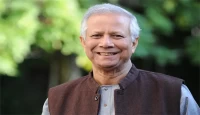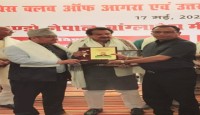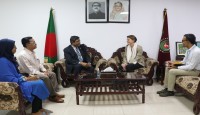Necessity of Mother Tongue in Primary Education: A
Chittagong Hill Tracts Perspective
Borendra Lal Tripura
Assistant Professor, AIUB
ADS & ALA Scholar
Shaila Ahmed
Senior Assistant Professor, AIUB
1. Abstract
Language plays a crucial role in making sense of the world. Without the mediation of language, it
is difficult for a child, or anybody for that matter to have access to reality. Given that the mother
tongue is considered the most effective way of receiving education, it is unfortunate that children
are to spend a huge amount of time learning a second or foreign language. However, when there
remains no option for using the mother tongue as the medium of education for a community,
there should be an emphasis on bilingualism as a solution for the time being. This paper focuses
on the rationale for introducing bilingualism considering the relevant challenges for
implementing it.
2. Introduction
When ethnic minority children go to school, what resources do they carry as an instrument of
communication and understanding? The unequivocal answer would be ‘the mother tongue’ and
‘the schema’ (pre-existing knowledge), which they learned from their parents, family members,
society and culture. If we take the words ‘mother tongue’ and ‘schema’ as a discourse in an
2
educational perspective, we will understand the necessity and rights of the children to have their
early education in a language that they understand or a language that helps them understand their
lessons and scaffold learning. ‘Schema’ implies that the content of their lessons should be
something that the children understand.
These are the basic considerations generally taken into account in determining the instructions of
primary education and syllabus design, but only the unfortunate children are the minority
children who have to start their early education with a language and contents which are unknown
to them. Hence the beginning of their schooling is not welcoming and entertaining for them,
rather it is like entering into a fearful unknown world.
It is a matter of hope that the government of Bangladesh has now decided through the CHT Peace
Accord 1997, clause 33a (2) to facilitate the ethnic minority children in having primary education
in their own languages, which is not yet implemented in the last ten years. This is why I am
interested to discuss issues relevant to primary education and mother tongue in this article.
3. Necessity of Mother-tongue in Child-education
Since the independence of Bangladesh, Bengali is the national language and the medium of
instruction in the mainstream schooling system. Apart from Bangla, there are other forty-five
languages of ethnic minorities as identified by the Summer Institute of Linguistics (SIL, 2007).
According to Ethnologue 2007, there are 38 other languages in Bangladesh. Because of the
absence of official recognition of the ethnic indigenous minority peoples’ languages and their
applications in the school instructions, the pertinent children are greatly hindered in acquiring
literacy and other cognitive developments. There is a significant drop-out rate in the primary
schools of CHT (ADB report). The Bradford Mother Tongue and English Teaching Project
(MOTET) and North American studies confirmed that the mother tongue can greatly help in
learning a second language as well as in overall intellectual development.
3
The UNESCO 1953 document also recommends,
“In particular, pupils should begin their schooling through the medium of the mother
tongue, because they understand it best and because to begin their school life in the
mother tongue will make the break between home and school as small as possible.”
The same voice is also heard in other influential pieces of legislation, the Directive of the Council
of the European Community (Brussels/77486/EEC) as it instructs member states of the European
Community to
‘Take appropriate measures to promote the teaching of the mother tongue and of the
culture of the country of origin of the children of migrant workers, and also as part of the
compulsory free education to teach one or more official languages of the host state” cited
in Romaine (1995, p. 20).
This upholds the necessity of bilingual education, which is a very effective education system
especially for minority people who need to maintain their language and at the same time must
learn the national language for life success. The Nobel laureate poet, Rabindranath Tagore (1913)
has also advocated in this regard that children should have the foundation of their mother tongue
before learning any other languages. Thomas and Collier (1997) found the same pulse in their
eight years long research over 700,000 school records of 42,317 students in minority children in
the USA using ‘mother tongue’ in their early education. Miller (1982) has given a vivid
explanation of the linguistic aspect of how the ‘mother tongue’ helps children in education. He
explained that because of the knowledge of the structure of the mother tongue, children become
more aware of the structure of other languages, which scaffolds the learning of other languages
faster. These imply that children should have education instruction through their mother tongue
in an earlier stage so that they can benefit from it, though of course, national language and other
foreign languages should be taught at the same time, which is rather given importance in the
present day schooling system. But learning other languages should not submerge the mother
4
tongue at any cost. That is why bilingual/multilingual education is prominently rising in the
education arena, especially in the multicultural and multilingual society, which plays a great role
in the literacy and cognitive development of children. In parallel, it helps to promote cultural,
communal and political harmonies.
3. Bilingual Education and Maintenance of Peace and Harmony
A bilingual education system is very essential in the CHT where more than half of the population
is a speaker of languages other than Bangla. But, of course, Bangla and English should be taught
at the same time. As there are thirteen ethnic minority races living in this region, who speak ten
different languages, the program will be multilingual for the schools and bilingual for the
individual child. This approach to education will, hence, help to achieve greater harmonies in this
region, because it will certainly relieve the minority communities from the feeling of deprivation
to a great extent, who underwent twenty-six years of ethnic and political conflicts for autonomy,
a political system which will give them the power to preserve their own language, culture,
heritage and identity. With this education system, they will also be assured of their language
maintenance and development. Houlton and Willey (1982) pointed out that ‘positive responses to
diversity’ and ‘encouraging bilingualism’ play a great role in racial harmony (p17) because they
will support the ‘self-esteem and positive self-image’ of minority children. This notion is
recognized by the National Union of Teachers (NUT) (1982) and is reinforced in its statement
about teaching the mother tongue: “Respect for ethnic minority pupils in our schools can be
fostered by the status accorded to their home and community languages.”
Bangladesh government has also realized the necessity of language maintenance and
development of the CHT people, which is reflected in the CHT Peace Accord, 1997, which was
signed with the local political party, Parbattya Photogram Jono Songhoti Somity (PCJSS). That
agreement was also passed in the national assembly of Bangladesh and widely appreciated by
international communities, such as the United Nations, Australia, Japan and Canada, for which
the then prime minister, Sheikh Hasina received the UNESCO peace award.
5
I believe, if clause 33a (2) of CHT Peace Accord 1997 is implemented, the CHT people will be
greatly happy and be assured of the maintenance and development of their languages, which is an
intrinsic part of their identity and existence. At the same time, this will provide them the feeling
of a positive image of their identity. As a result, it will promote peace and harmony in this region.
4. Why Bilingual Education?
Some may ask why I am emphasizing bilingual/multilingual education in implementing the
introduction of local languages in the primary schools of CHT. Is it not enough to introduce the
local languages right away? I would say “No” in response. I would prefer to advocate that the
whole instruction in primary schools should not be in the local languages alone. The curriculum
instructions must include the national language (Bangla) and the international language (English),
because the foundation of national language should be seeded into primary education for the
following reasons:
(i) After primary education, children are going to secondary schools, where they will be
exposed entirely to the instructions of the national curriculum, which are Bangla and
English. So, they must be prepared for that too.
(ii) During the course of study, some of the students may be shifted to other districts than
CHT because of the transfer of postings of the parents (those who are employed).
(iii) Though primary education is necessary for their own languages for different reasons,
the broader future socio-economic implications are also similarly important.
I would, therefore, argue for introducing bilingual/multilingual education in the primary schools
of CHT.
6
5. The Policy Issues
To address the policy issues for the purpose stated in this paper, there are several issues, which
we must consider. I am concretely interested in such issues as the diversity of language, culture
and ethnicity of the CHT; legal issues of the program, administration and curriculum including
alphabet and course materials or course content.
One very striking point here is that the literacy rate of the CHT indigenous people is high enough
to run schools in their own languages (bilingualism). Moreover, most of the existing population
of teachers in the primary schools of CHT is ethnic minority people. UNDP is interested to
provide funds for this program. So, there is no problem for human resources in implementing
bilingual education in this region except for the policy issues. So, I believe, a government
declaration of the policy will enable the implementation of the local languages in the local
primary schools.
However, the following issues should be taken into close consideration for the policy framework:
5.1 Diversity of language, culture and ethnicity of CHT:
CHT is a multi-ethnic, multilingual, multicultural and multilayer administrative region,
which is different from the district on the plains. The social setting, lifestyles, food habits,
beliefs and behaviors are significantly different from the majority Bengali society. While making
a policy decision about CHT and its people, all these divergent elements must be counted if it is
aimed at bringing interests and benefits to them.
5.2 Legal issues
As mentioned above, the CHT peace agreement has been approved by the national parliament of
Bangladesh, there is no more legal obstacle to implementing the local languages in the local
primary schools. The only necessity is to circulate administrative rules and order, which is not a
difficult issue. However, I will seek to identify principles in my further studies on which the
7
administrative rule and order should be based. I hope to identify principles that support
multilingual immersion programs so that every child can be bilingual (their own mother tongue
and Bangla).
5.3 Administrative Process
To run the program successfully and effectively, there should be some administrative process,
which may be ranging from the ministry to local committee including teacher training,
monitoring and evaluation.
5.4 Curriculum
The current curriculum in the primary schools of CHT is similar to all other schools of the
country, which is devised keeping the mainstream children in mind completely ignoring the
diversity of language and culture of the marginal children, e.g. CHT. Consequently, it is suitable
for the Bangla speaking children. On the other hand, the curriculum and medium of instruction
appear to the ethnic minority children as a great challenge, which instead of attracting the
children to the schools, scares them away with fear. It is common sense that in syllabus design,
children should be introduced to an unknown world through the known world and things should
be explained to them in a language that they understand well. But in the case of CHT and other
ethnic minority children, both the curriculum content and the medium of instruction are totally
unfamiliar, which is like throwing them into an unknown city to find out the way to come back
home. But the effective strategy should be vice versa. That is why a curriculum framework
should be sought based on bilingualism and immersion theory which will allow the children to go
the city along the way from their home, the familiar way to the unknown.
6. Policy Development and Implementation Process
Finally, a policy development and implementation process should be drawn on the basis of policy
theory which is compatible with ethnic minority children to ensure the philosophy of education
for all and equal opportunity for all children.
8
7. Conclusion
In conclusion, I would like to pose that a country could be multi-ethnic and multi-cultural, where
the language of the largest community could be the national language, which is, in fact, the
reality of all almost all nations and countries, but should language, culture and heritage of the
minority people be ignored for all times? A country is like a family where there may be many
children, but should only the big brother or sister take all the opportunities? If the answer is ‘yes’,
then we cannot expect peace and harmony in that family. Instead, we will always find clashes and
conflicts in that family, which is not expected in a modern and civilized family. As a family of
nations, it is the responsibility and liability of the big brothers and sisters to maintain and ensure
the well-being of all the junior siblings, to fulfill their needs to help them grow as good family
members. It is true that the ethnic minority people of CHT are part of the Bangladeshis, which
means, leaving them ignorant and disadvantaged is similar to leaving a part of the body disabled.
Moreover, if we are concerned about the dominance, the percentage of the CHT people is so
small that it is not even 1% of the total population. So, their existence and prosperity will never
be a threat to the dominance of the majority community. It is, therefore, for all reasons, beneficial
for the nation and for the state to help all communities grow. Their growth is the growth of
Bangladesh, their prosperity is the prosperity of the nation. So, for the maintenance of peace,
prosperity, harmony and growth of the whole family, for the cognitive and literacy development
of the CHT children, for the maintenance and development of their languages, and for
distributing of opportunities and rights, it is necessary to implement the ethnic minority
languages of CHT in the local primary schools, which was realized and agreed in the CHT Peace
Accord, 2007. I hope that the issues discussed above will bring light into the program, especially
the diversity of the region, legal issues, administration and curriculum including alphabet and
course content should be reflected, though there may be some limitations in the overall
discussion, which could be improved and developed through monitoring, evolution, training and
further studies. But the utmost necessity is to start the program.
9
8. Bibliography:
Asian Development Bank (2001), Final Report No. 8: Education in the CHT, Rangamati
Babbie, E. (2005), The Ethics and politics of Social Research in “Basics of Social
Research”, Thomson Wadswort, p59-83.
Chittagong Hill Tracts Peace Accord, 1997.
Creswell, J. W. (1999), Mixed-Method Research: Introduction and Application in
Handbook of Educational Policy by Cizek, G.J (1999, ed), Academic Press: California.
Houlton and Willey (1983) Supporting Bilingual children’s bilingualism. York:
Longman.
Johnson, B & Christensen, L, (2004), Quantitative, qualitative and mixed approaches in
“Educational research: quantitative, qualitative and mixed approaches”, Pearson Ed
Inc., p28-53
Miller, J (1982), How do you spell Gujrati, sir? In Alan James and Robert Jeffcoate, eds.,
The Schools in the Multicultural society. Harper and Row.
Mother Tongue and English Teaching Project (MOTET), Bradford College, 1981
National Union of Teachers, Mother-tongue Teaching. NUT, 1982
www.sil.org (accessed in May, 2007)
http://www.ethnologue.com/show_country.asp?name=BD ) (accessed in May, 2007)
Terre Blanche, M. & Durrheim, K. (eds), (1999), Histories of present: social science
research in context; Research in Practice” Applied Methods for Social Sciences.
University of Cape Town Press. pp. 1-16
Thomas, W. and Collier, V. (1997), School Effectiveness for Language Minority
Students . Conference Paper (presented in American Anthropological Association in 1997)










.jpeg)
